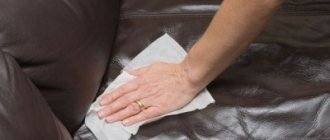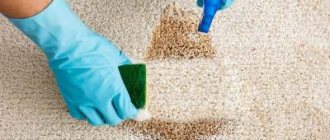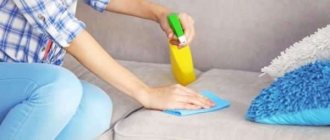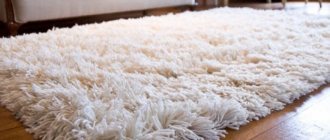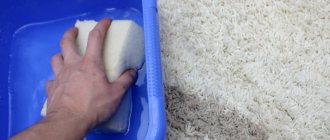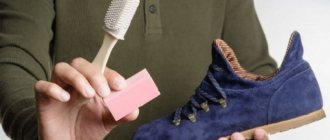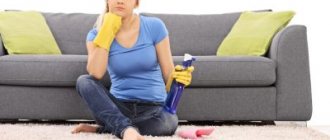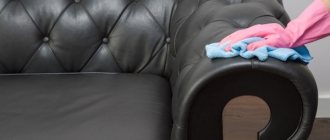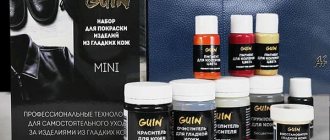/Order/
Professional dry cleaning of a sofa, upholstered chairs, armchairs or other upholstered furniture is an expensive service. Sometimes you can’t do without it, but in most cases, even complex stains like blood stains, baby urine, wine, etc. can be removed on your own for mere pennies.
- In this material, we presented 2 step-by-step guides on how to clean a sofa at home, using products that are found in every home.
Surface preparation
Before you start cleaning your sofa at home, you need to do the following:
- Decide on the type of detergent. What is suitable for leather furniture is sometimes not recommended for use on models with fabric upholstery and vice versa.
This is the most important point; not only the result of home cleaning, but also the safety of the sofa surface will depend on it, so when choosing a product (improvised or industrial), strictly follow the recommendations for its use.
- Thoroughly vacuum the fabric surface or wipe with a soft cloth if the sofa is made of genuine leather or substitutes. This stage should never be skipped, since by ignoring it, you can add dirty stains to the existing stains, which will then be problematic to remove from light-colored furniture.
- Pre-treat existing stains with special products. If the sofa does not have pronounced stains, then you can immediately begin cleaning with the chosen product.
Thus, in order to clean the sofa without streaks, you need to choose the right product that will not damage the surface and tidy up the upholstery.
Leather sofas and microfiber models are the most resistant to stains and streaks and are easy to care for, unlike capricious materials such as jacquard or tapestry.
Some upholstery is specially impregnated with compounds that repel dirt and thereby make the furniture easier to care for.
Basic Precautions
When working with solvents and other aggressive chemicals, wear gloves and try to protect the skin of your hands, face and especially your eyes. If toxic liquid does come into contact with your skin, immediately rinse the affected area thoroughly with warm water. Before using aggressive chemicals, place plastic bags or old newspapers on the floor around the sofa.
When working with household chemicals, you must wear gloves.
Most stains can be easily removed from the surface of the sofa even without the use of special cleaning products. The main thing is not to delay cleaning and try to remove the stain as quickly as possible. Without waiting for it to be absorbed into the surface.
How to clean a fabric sofa
Before cleaning, it is better to test all products for treating upholstered furniture without exception in hidden places (under or behind the sofa).
It is imperative to take into account each condition for processing individual upholstery materials.
Flock.
Before cleaning a flock sofa, you need to make sure that the product you choose does not include ethanol. Immediately after cleaning, you can go over the upholstery with a soft-bristled brush to smooth out the lint.
Microfiber.
To clean a microfiber sofa at home, you must use only dry methods. Wet cleaning is only possible in extreme cases.
Advice! To clean a snow-white sofa, you should use only white rags. Multi-colored fabric under the influence of detergents can color light-colored upholstery. Do not use bleach or pure vinegar.
What causes stains on the sofa?
In any room, despite the frequency and intensity of cleaning, dust accumulates on surfaces. Sofas and easy chairs are no exception.
Cleaning upholstered furniture more often is a rule of a good housewife.
And if you wipe the dust from the upholstery of such furniture without following certain rules, you can see whitish stains or the outlines of stains on the upholstery fabric.
Sometimes such a nuisance occurs due to insufficient removal of detergent from the surface. Sometimes stains remain after drying, especially if it contains a lot of salts.
Sometimes stains on sofas appear from food.
Most often, stains remain on the upholstery of upholstered furniture if the felt, foam rubber and padding polyester used to cover the sofa frames are excessively wet.
Types of stains and methods for removing them
To remove stains from the surface of the upholstery, you can try a universal home method that is suitable for absolutely all types of materials. This is soap suds or a solution of detergent for cleaning carpets. It is necessary to apply the foam to dirty areas, let it work for 15-20 minutes, and then wash the coating clean, removing excess water with a rag.
If the stain still remains, try to remove it using the following compounds:
- 2 tbsp. l 9% vinegar per 1 liter of water;
- a solution of shampoo in water with the addition of 10–11 drops of ammonia.
In most problematic situations, these simple operations are quite enough to free the upholstery from stains of tea or coffee, chocolate or white wine, as well as beer, jam, cola, etc.
If these home methods are not enough, then you should resort to more effective methods that are used separately for each category of pollution.
Blood
Fresh blood stains should be immediately moistened with cool water until they disappear completely. If the stain is already old, then it can be kept under ice cubes, after wetting it with a weak solution of vinegar (2 tablespoons of vinegar per 1 liter of water). Finish the treatment with soapy water and dry.
Fruit or vegetable juices
Apply a mixture of ammonia and 9% vinegar to the stain, then wash the surface with a clean, wet cloth.
Red wine
Blot the fresh wine stain with a napkin and cover with fine salt. Give the salt a little time to absorb the water, then shake it off with a soft-bristled brush and wash the stain with ethyl alcohol, and then with soap suds. At the end of the treatment, remove parts of the soap with water and dry the cleaning area with napkins.
Ink, markers, or lipstick marks
Easily cleaned with simple acetone or ethyl alcohol. You can also remove ink and marker stains with women's hairspray.
Gum
Removed by freezing with ice cubes. The remaining stain can be wiped with alcohol and dried.
Fat
Grease stains must be covered with salt for a while. Then the fat is easily washed off with a solution of any dishwashing detergent.
Dust
If, after cleaning with a vacuum cleaner, untidy stains and stains remain on the light-colored upholstery, you should wash them with a solution of any hair shampoo, which will completely remove all dirt.
The most important
- A few drops of detergent are added to the water and foam is whipped on the surface of the liquid.
- A small amount of foam should be placed on the area requiring cleaning.
- You need to wait 5-10 minutes.
- Contaminants are carefully rubbed with a soft brush.
- Use a dry cloth to remove any remaining detergent.
- substances contained in urine are poorly soluble in water, so strong chemicals are needed to clean stains;
- Various pathogenic microorganisms actively multiply in dried stains, so the smell persists for a long time, and it can be very difficult to remove it;
- Even if you cleaned the upholstery, the liquid probably penetrated into the sofa filler.
Folk remedies Recipes for masks At home Hair loss in women How to stimulate growth Causes of hair loss Hair loss in men Review of vitamins Helpful tips
Traditional methods for cleaning greasy upholstery on upholstered furniture
Greasy marks and abrasions that appear on the surface of the sofa during use can be removed using folk remedies.
In every kitchen there is vinegar, soda or salt, and in the bathroom there is laundry soap or shaving foam. Some housewives have ammonia in their medicine cabinet. All of these products can be used to clean upholstery.
Before choosing a recipe, consider the type of sofa upholstery. Not all fabrics can be wetted or scrubbed with a brush.
Salt
- Old stains are removed with a strong saline solution.
- Dissolve 2 tablespoons of salt in a liter of warm water.
- The composition is applied to the stain and after a third of an hour is removed with a slightly damp sponge.
- Stains that have appeared recently can be sprinkled with salt. After 15-20 minutes it is removed with a vacuum cleaner.
Soda
Sodium chloride helps remove grime from sofa upholstery. There are several ways to do this:
- Blot the stains with a damp sponge or cloth and sprinkle with baking soda. After 30 minutes, wipe the upholstery with a brush or microfiber cloth. Wait until the treated areas dry and vacuum the sofa. Use a damp sponge or cloth to wipe the surface.
Rinse them as often as possible - this will eliminate streaks.
- Old stains can be removed with soda paste. It is mixed with water in a 1:1 ratio. Apply to the worn area and gently rub into it with a soft bristle brush. After an hour, if the sofa is dry, it is vacuumed. Remains of soda are removed with a damp sponge or cloth.
- A mixture of baking soda, water and dishwashing liquid can remove heavy stains. Mix two tablespoons of baking soda and detergent in a liter of water. Stir and apply foam to problem areas. After 15 minutes, the composition is removed with a damp cloth.
Vinegar and soda
A mixture of 9% vinegar with the addition of soda gets rid of grease and returns brightness to the upholstery.
What you will need:
- Spray bottle with a capacity of 1 liter.
- 100 milliliters of vinegar.
- 0.5 liters of water.
- A tablespoon of soda.
Add vinegar and soda to the water. Screw on the spray bottle. Spray the mixture onto the upholstery. Leave for 10 minutes. The solution is removed using a soft cloth or foam sponge.
If necessary, it is reapplied. After the stains have been removed, wipe the treated area with a cloth soaked in clean water.
Laundry soap
You can remove scuff marks from the armrests, back or seat of the sofa using laundry soap.
What you will need:
- Capacity of more than 5 liters.
- Grater.
- A piece of laundry soap.
- Rag or brush.
You need to grate the soap, dissolve the shavings in water, and whip up the foam. Rub it onto problem areas and leave for 10 minutes. Wipe gently with a brush or microfiber cloth.
If you don’t want to bother with soap shavings, you can lightly moisten the greasy area with a spray bottle and rub it with laundry soap. Leave the product for 10 minutes, then remove with a damp cloth and brush.
This method requires less preparation time. It will take a little longer to remove soap from the sofa. Upholstery made from pile fabrics should only be cleaned in the direction of the pile.
Ammonia
- To clean upholstery from grime, you can use ammonia:
- It is diluted with water 1:1.
- Stains are wiped with a cosmetic disc or soft cloth.
- After the grime has been removed, the surface is wiped with a damp, clean cloth.
Shaving foam
You can remove dirt from light-colored upholstery using shaving foam. A small amount is applied to the stains and gently rubbed in with your hand.
After 20-30 minutes, the foam is removed with a damp sponge, then the sofa is wiped with a dry microfiber cloth.
On old stains, the product can be left overnight. They start cleaning the sofa from the back, then move on to the seats, then the armrests.
Chemicals
In addition to folk remedies, you can also buy chemical cleaners in stores. Such means of cleaning a sofa at home have their advantages:
- Easy to use: the product is completely ready
- Fast acting: usually a few minutes are enough
However, they also have disadvantages:
- May cause allergies
- Corrodes fabric and dyes
These products contain artificial industrial substances, fragrances and harsh ingredients - all of which can cause coughing, sneezing, skin rashes or a runny nose. Considering that the substances are applied to a large area of furniture, the effect of allergens becomes very strong.
The second disadvantage of chemistry is that the composition is too aggressive. Regular use of these substances will discolor paints and corrode upholstery. It makes sense to use such products only in rare cases - when you need to quickly wipe off heavy dirt.
Ready-made chemicals
You can also clean the sofa with chemicals. While studying the sofa cleaning product, we familiarize ourselves with its description and rules of use. The description indicates what type of fabric it is intended for:
- "Vanish " The line of this product includes shampoo, antibacterial agent and powder. For coatings that do not tolerate moisture, we use the latter (cleaning using the dry method);
- "Marseille Soap" . Contains olive oil and baking soda. Used to clean small stains. Wet the soap, rub the stained area and after 20 minutes rinse with a damp cloth;
- "Denkmit" - foam for cleaning carpet and sofa upholstery. We use it for velvet, tapestry and silk coverings;
- "Sama " Effectively fights old stains, dirt and bacteria;
- Bagi "Shtihonit" . We use it as a stain remover and as a complete cleaning agent;
Advice! Do not let the product dry, otherwise it will leave streaks that are difficult to wash off.
We also recommend that all housewives find out how to wash kitchen towels from old grease stains and odors.
- "Pro Brite " An environmentally friendly product, suitable for people with allergies. It has a sprayer that is convenient for applying the product to local areas of the upholstery;
- "Dufta" , "Simple Solution" , "Nature's Miracle" . These products effectively combat unpleasant odors and completely eliminate them.
How to clean upholstered furniture at home
Cleaning methods are divided into dry and wet. Different methods are used depending on the complexity of the dirt, the frequency of cleaning and the time allocated for cleaning.
In addition to the sofa, you also need to regularly care for:
- Armchairs
- Chair seats
- Cushions and poufs
People often forget to clean such furniture, but dust and pet hair also accumulate here, which becomes a breeding ground for infections and bacteria. As a rule, dry cleaning is used to care for small upholstered furniture.
Dry cleaning
This method is the simplest, as it does not require the preparation of special solutions or drying of furniture. Dry cleaning is recommended once a week. For it they use:
- Brush
- Vacuum cleaner
- A spatula for knocking out.
The easiest way to care for furniture is with a brush. A product with stiff bristles is suitable for this. The brush cleans velor, pile, and fur capes well.
It makes sense to use a vacuum cleaner for tapestry or matting. It is effective to combine cleaning with a vacuum cleaner and a brush.
Wet cleaning
Wet cleaning is recommended once a month. This rhythm will allow you to keep your upholstered furniture always neat and new. Regular wet cleaning will protect against the appearance of severe grime and old stains.
Wet cleaning has one feature - after it you need to dry the furniture, otherwise mold will grow in it. You can cover the sofa with a blanket, blanket or cape only after it has completely dried.
There are different ways to dry furniture:
- Vacuum cleaner
- Dry towels
- Hairdryer
- Natural drying
A vacuum cleaner uses air circulation to help moisture evaporate faster. This allows the sofa to dry naturally. At the same time, it helps remove moisture from deep layers if it gets there.
Dry towels help dry only the top layer of upholstery. To do this, they are laid out on furniture and removed after 1-2 minutes. The procedure can be repeated several times.
Use a hairdryer to dry deep and heavily moistened areas. It is usually used when something has been spilled on a product. In this case, it is better to dry with cold air. High temperatures can dry out the filling of sofa cushions.
When drying, the hair dryer should also not be brought too close to the product; it is better to keep it at a distance of 20-30 cm.
It is better to carry out natural drying with the windows open - this way the furniture will dry faster. They always complete all drying procedures. However, this method is not so fast.
Pollution prevention
To avoid stains, it is recommended to use capes, blankets or covers. In any furniture store they are presented in a wide range. These capes are easy to remove and wash. In addition, they can be shaken out regularly, which will rid the apartment of dust, pet hair and bacteria.
The use of capes and bedspreads is not only hygienic, but also allows you to periodically change the interior.
Folk recipes for cleaning a sofa with baking soda at home
Dry cleaning.
For removing light stains and unpleasant odors (urine, beer), for cleaning a light-colored sofa or delicate upholstery that does not like moisture
- Sprinkle dry soda thickly onto the contaminated area of the sofa or the entire upholstery.
- Leave for about an hour.
- Remove the soda with a vacuum cleaner.
- If the smell remains, you need to repeat the procedure.
Wet processing.
To remove grease, refresh color, to treat the entire sofa or its individual parts, to remove stains from tea, coffee, dirt, paint, ballpoint pens
- Dampen a clean sponge with water and wipe the upholstery with it. The fabric should become damp.
- Sprinkle the sofa generously with dry soda.
- Leave everything for half an hour.
- Rub the upholstery with a soft furniture brush or dry cloth. Pay special attention to the most contaminated areas.
- Allow the sofa to dry completely (this will take up to two hours).
- Vacuum the fabric thoroughly.
- Wipe the upholstery with a damp sponge or cloth to remove any remaining soda. Rinse the sponge frequently in clean water.
- Dry the clean sofa.
Cleaning with soda slurry
This method also helps remove grease, tea, coffee and dirt stains. It is more effective, but also more complex to implement than the previous one.
- Mix soda with water (1:1).
- Spread the resulting pulp evenly over the surface of the sofa.
- Rub the product into the upholstery with a soft, short-bristled brush.
- Leave everything for an hour. The sofa should be completely dry during this time.
- Vacuum the upholstery. If necessary, wipe it with a damp cloth to remove any remaining soda.
Cleaning with soda solution
This method is suitable for quickly cleaning a sofa from light stains with baking soda. Suitable only for upholstery that is not afraid of moisture.
- Prepare a cleaning solution – 2 tbsp. l soda per liter of water.
- Pour it into a spray bottle and spray it over the upholstery of the sofa.
- More contaminated areas can be moistened with more solution and rubbed with a brush. Then remove excess moisture with a clean sponge.
- Allow the upholstery to dry completely and vacuum it.
General cleaning with baking soda and detergent.
To remove heavy dirt, stubborn stains, and traces of urine.
- Mix a liter of water, 2 tbsp. l. soda and 2 tbsp. l. dishwashing detergents, for example, “Fairy”. Instead of detergent, you can use laundry soap or colorless shampoo.
- Lather the solution with a sponge or hand.
- Apply foam to sofa upholstery.
- Leave everything for 5-10 minutes.
- Rinse off cleaning products thoroughly with a sponge and clean water.
Powerful cleaning of the sofa with soda, vinegar and Fairy.
- An even more effective product for general cleaning and removing the toughest stains
- You need to mix 1 tsp. “Fairy”, about 150 ml of vinegar (9%) and half a liter of hot water.
- It is more convenient to pour the solution into a spray bottle, but it can also be prepared in a basin.
- Lastly, add 1 tbsp. l. soda The mixture will foam.
- Spray the sofa with a solution from a spray bottle or moisten it with a sponge.
- Scrub all upholstery or the most dirty areas with a brush.
- Rinse off the dirty solution with clean water.
Cleaning the sofa with alcohol and soda.
For removing fresh grease stains
- Sprinkle a thick layer of baking soda on the stain.
- Wait one to two hours. If there is a lot of fat, you should remove the soda as soon as it is soaked and add fresh.
- Remove dirty baking soda with a brush or vacuum cleaner.
- Wipe the remaining stain with a cotton pad soaked in alcohol.
Cleaning the sofa with baking soda and peroxide.
- For removing stains from fruits, berries, juices, “colored” vegetables, wine, tea and coffee
- Mix soda and hydrogen peroxide (3%) in a ratio of 1:2.
- Apply the solution to the stain and wait until it discolors. Be careful as peroxide can also bleach the dyes in the fabric itself.
- Remove the product from the upholstery with a damp sponge.
- Rinse the fabric and dry the sofa.
Cleaning a leather sofa.
For removing shiny stains from leather, eco-leather and leatherette
- Prepare a soap-soda solution (1 tablespoon of grated laundry soap and baking soda per liter of warm water).
- Soak a sponge or soft flannel in the cleaning solution, wring it out and gently wipe off the dirt.
- Wipe the treated areas with a cloth soaked in clean water and then with a dry towel.
- After cleaning, be sure to apply a protective agent (conditioner) to care for the leather on the sofa.
We looked at the best methods and talked about how to clean the sofa upholstery from grease, dirt, and grease.
If you have tried everything, but the stain cannot be removed, then contact a dry cleaner, whose specialists will come to your home with all the necessary equipment and chemicals.
Other Common Spots
Most stains can be easily removed with baking soda. The recipe is simple: pour directly onto the upholstery of the sofa, sweep it off with a clothes brush after 15 minutes.
One of the universal means for cleaning a sofa is soda.
You can try to remove absorbed stains using slightly heated glycerin, an aqueous solution of ammonia (1 to 5) or vinegar essence (1 to 2). Don't forget about household chemicals. There are many universal stain removers and special products for various types of upholstery on sale.

